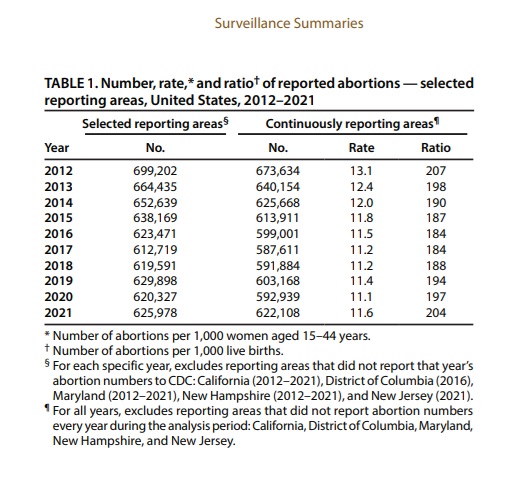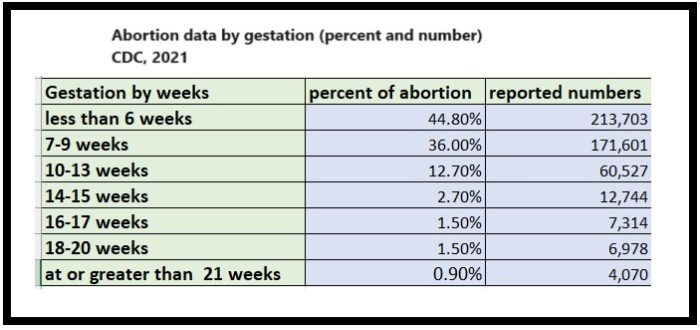The Centers for Disease Control and Prevention (CDC) has released its latest abortion data revealing that 625,978 abortions were reported from 48 reporting areas for 2021. This represents an increase of less than one percent (<1%) from the 620,327 legally induced abortions reported to the CDC for 2020.

Abortion data from CDC 2021 to 2021 totals and continuous reporting areas
Abortion numbers have been ticking upward since 2017. In 2020, the Guttmacher Institute recorded 930,160 abortions committed nationally — an increase of 67,840 over 2017. More recent estimates published by #WeCount indicate that between June 2022 and June 2023, over one million abortions were committed nationwide.
2021 Abortion Data
The 2021 abortion data was provided to the CDC voluntarily from state health agencies in 48 reporting areas (46 states, the District of Columbia, and New York City). The abortion totals for 2021 excluded states that typically record the highest number of abortions: California, Maryland, New Hampshire, and New Jersey. Not all 48 reporting areas reported all of the same data, such as gestational age at the time of the abortion or a woman’s race.
It is important to note that there has never been a federal mandate that all abortion data be reported.
In addition, data provided to the CDC only includes abortions obtained legally and may not include mail-order abortion pills sent from international groups such as Aid Access.
“An abortion is categorized as legal when it is performed by a licensed clinician within the limits of state or jurisdiction law,” the CDC report stated.
Who had the most abortions?
In 2021, 57% of abortions were committed on women in their 20s while 87% were committed on unmarried women. Teens obtained the greatest percentage (30%) of abortions that were committed at or after 14 weeks among the various age groups.
“In 2021, women in their 20s accounted for more than half of abortions (57.0%),” the CDC wrote. Those under 15 years of age and those over age 40 accounted for the lowest percentage of abortions and had the lowest abortion rates. However, abortion ratios were highest among adolescents. Girls under age 15 had 805 abortions per 1,000 live births and there were 381 abortions per 1,000 live births among those aged 15–19 years.
READ: Why there can be no ‘middle ground’ on intentionally killing innocent human beings
Also in 2021, abortions committed on women who had a previous live birth (60%) outpaced the number of abortions committed on women who had never experienced a live birth (39%). Nearly 60% of women reported never having had a previous abortion in 2021, while 42% had previously undergone at least one previous abortion.
In 2021, Black women accounted for a disproportionately larger percentage of abortions in both rate and ratio. Between 2020 and 2021, the abortion percentage among Black women increased nearly six percent (6%) from 39.2% in 2020 to 41.5% in 2021, while the abortion percentage among Hispanic women increased by over three percent (3%). Abortion is tethered to eugenics, and minority communities appear to still be targeted for eugenic abortions. A more detailed analysis of abortions by race and ethnicity will be published in a separate article.
Later abortions
“For 2021, among the 41 areas that reported gestational age at the time of abortion, 80.8% of abortions were performed at ≤9 weeks’ gestation, and 93.5% were performed at ≤13 weeks’ gestation,” CDC wrote.
The CDC claimed that fewer abortions were performed at 14–20 weeks’ gestation as well as at or after 21 weeks’ gestation.
Some of the reporting states allow abortions into the later weeks of pregnancy and are home to the most notorious late-term abortion facilities in the nation. Therefore, it is doubtful that we will ever know just how many preborn babies are violently killed into the last months or weeks of pregnancy when they are much more likely to survive outside the womb.
What the CDC’s abortion data indicates is that 4,070 preborn babies were recorded as being aborted at or past 21 weeks of pregnancy in 2021.

Abortion data by gestation CDC 2021
Abortion rate
“Among 47 reporting areas with data each year during 2012–2021, in 2021 … the abortion rate was 11.6 abortions per 1,000 women aged 15–44 years, and the abortion ratio was 204 abortions per 1,000 live births,” the CDC claimed.
Looking at just those 47 reporting areas, the data revealed that:
- Between 2020-2021, the number of abortions increased by 5% (from 592,939 total abortions). Between 2012 and 2021, the total number of reported abortions decreased overall by 8% (from 673,634).
- Between 2020-2021, the abortion rate increased by 5% (from 11.1 abortions per 1,000 women aged 15–44 years). Between 2012 and 2021, the abortion rate decreased by 11% overall (from 13.1 abortions per 1,000 women aged 15–44 years).
- Between 2020-2021, the abortion ratio increased by 4% (from 197 abortions per 1,000 live births). Between 2012 and 2021, the abortion ratio decreased by 1% overall (from 207 abortions per 1,000 live births).
If any reporters want some comments on the newly released @CDCgov abortion data, feel free to DM me.
Abortions increased by about 5% between 2020 and 2021. The increase in chemical abortions played a large role in this abortion uptick.
— Michael New (@Michael_J_New) November 22, 2023
“White women had the lowest abortion rate (6.4 abortions per 1,000 women aged 15–44 years) and ratio (116 abortions per 1,000 live births), and Black women had the highest abortion rate (28.6 abortions per 1,000 women aged 15–44 years) and ratio (498 abortions per 1,000 live births),” the CDC reported.
Abortion pill
Abortion data by method type (which included gruesome procedures such as intrauterine or instillation and hysterectomy or hysterotomy abortions) “excludes six reporting areas… Areas reporting by method type with unknown gestational age or by method type where gestational age reported was not compatible with categorizations presented in this table are included,” CDC claimed.
Among the 46 areas that reported abortion by method type for 2021 and included chemical abortion (the abortion pill) on their reporting form, 53% of abortions were early chemical abortions (at or before nine weeks’ gestation), 37.6% were surgical abortions at or before 13 weeks’ gestation, 6.4% were surgical abortions after 13 weeks’ gestation, and 3.0% were chemical abortions after 9 weeks’ gestation. Other methods, including intrauterine instillation and hysterectomy/hysterotomy, were rare.
According to the CDC, there were 299,449 instances of abortion by pill use at or before nine weeks and there were 17,155 instances of the abortion pill use after nine weeks.
Additionally, data from 40 reporting areas broke chemical abortion data down further to include gestational ages past the Food and Drug Administration (FDA) approved 70 days/10-week limit:
- 10-13 weeks: 2,231 chemical abortions were reported (20.6%).
- 14-15 weeks: 158 chemical abortions were reported (1.3%).
- 16-17 weeks: 122 chemical abortions were reported (1.7%).
- 18-20 weeks: 207 chemical abortions were reported (3.1%).
- At or greater than 21 weeks: 458 chemical abortions were reported (12.3%).
Abortion pill failures increase as the gestational age of the baby increases. This can result in incomplete abortions, which can be potentially dangerous for women.
We have no idea how many abortions are committed past the approved FDA limits because, according to the CDC, the data “excludes 12 reporting areas (California, Connecticut, District of Columbia, Illinois, Maryland, Massachusetts, Missouri, New Hampshire, New Jersey, New York State, Pennsylvania, and Wisconsin) that did not report, did not report by weeks of gestation, did not meet reporting standards, or did not have medication abortion as a specific category on their reporting form.”
Abortion related deaths
The CDC recorded six abortion-related deaths for women for the year 2020, the latest data available. The number of women dying from abortion increased 50% from the four deaths recorded in 2019 and increased 200% from the two deaths recorded in 2018.
The government agency defines an abortion-related death as “a death resulting from a direct complication of an abortion (legal or illegal), an indirect complication caused by a chain of events initiated by an abortion, or an aggravation of a pre-existing condition by the physiologic effects of abortion,” the report stated.
CDC also noted that from 1998 to 2020, abortion surveillance data reported to the CDC… excluded “eight reporting areas” which “did not report abortion data every year during this period.” These included “Alaska, 1998–2000; California, 1998–2020; the District of Columbia, 2016; Louisiana, 2005; Maryland, 2007–2020; New Hampshire, 1998–2020; Oklahoma, 1998–1999; and West Virginia, 2003–2004,” the report claimed.
In other words, while six abortion-related deaths were recorded in 2020, these did not include abortion deaths that could have occurred in states like California, Maryland, or New Hampshire.
The number of abortion-related deaths has now risen to 460 deaths from legal abortion recorded by the CDC between 1973 and 2020, with additional amounts reportedly killed in illegal abortions.








